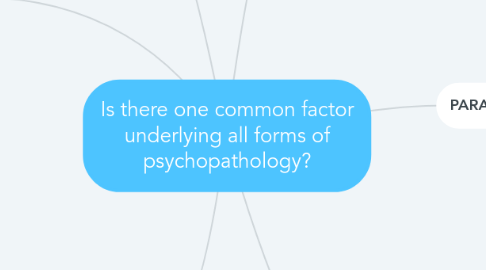
1. PARAGRAPH FOUR
1.1. However the p factor has been questioned as to its usefulness and validity.
1.1.1. It has been argued that 'Some commentators have wondered whether such a general factor is real and meaningful or merely factor-analytic foolery'. McNally R, Robinaugh DJ, Wu GW, Wang L, Deserno MK, Borsboom D. Mental disorders as causal systems: A network approach to posttraumatic stress disorder. Clin Psychol Sci. 2015;3:836–849.
1.1.2. It has also been considered to be a 'measurement artifact reflecting nothing more than a biased response style in which people systematically endorse (or deny) all symptoms'. Lahey BB, Rathouz PJ, Keenan K, Stepp SD, Loeber R, Hipwell AE J Child Psychol Psychiatry. 2015 Apr; 56(4):415-22.
2. CONCLUSION
2.1. Discuss that there is clearly value to the P factor.
2.2. Uses - That people could be tested to see if they are more susceptible to having a mental disorder due to having a high p value.
2.3. Could test to see if it is hereditary and therefore attempt to prevent or at least have more control and time to prepare for a specific mental illness.
2.4. Add a reminder that these studies, although detailed, do only focus on realistically small number of participants from a very specific area and that research has not been widespread geographically.
3. PARAGRAPH THREE
3.1. Neumann et al. 2015 Looked at young age group
3.1.1. They looked to define 'a multi-informant general psychopathology factor in school-aged children and estimated its single nucleotide polymorphism (SNP) heritability'
3.1.2. 'general psychopathology factor was associated with lower IQ, higher negative affectivity, and lower effortful control'
3.1.3. Useful as shows heritability links.
3.1.3.1. general psychopathology factor showed a significant SNP heritability of 38% (SE = 0.16, p = .008).
3.1.4. It was found that 'Common autosomal SNPs are pleiotropically associated with internalizing, externalizing, and other child behavior problems, and underlie a general psychopathology factor in childhood.'
4. INTRO
4.1. Define Psychopathology
4.2. Define and explain comorbidity
4.3. Suggest that although it is commonly thought that although there is comorbidity between different mental disorders that it is not often considered that there is only one common factor underlying them all.
5. PARAGRAPH ONE
5.1. There is one common factor according to research by Caspi et al. 2014.
5.1.1. P factor - (define) - 'conceptually parallels a familiar dimension in psychological science: the g factor of general intelligence'.
5.1.1.1. General Psychopathy is represented by a factor that directly influences all of the diagnostic symptom factors
5.1.1.2. '‘g’ dimension reflects low-to-high mental ability, the ‘p’ dimension represents low-to-high liability to develop any common mental disorder'
5.1.2. They initially looked at mental disorders through three 'higher order factors' - Internalizing, Externalizing, and Thought Disorder. Found that the one general factor explained things better.
5.1.2.1. Higher p scores are associated with more life impairment, greater familiality, worse developmental histories, and more compromised early-life brain function
5.1.3. Looked at previous research into twin studies that showed 'that there are substantial phenotypic correlations among pairs of psychiatric disorders but also that the liability to many disorder pairs'.
5.1.4. Found correlations between the three 'higher order factors' (aka spectra's).
5.1.5. 'Given high correlations at the spectrum level, Lahey et al. (2012) suggested the intriguing possibility that in addition to propensities to specific forms of psychopathology (e.g., Internalizing vs. Externalizing), there may be one underlying factor that summarizes individuals’ propensity to develop any and all forms of common psychopathologies.'
5.1.6. Decent study - 1000+ people, longitudinal, BUT only in one area in New Zealand...
6. PARAGRAPH TWO
6.1. In other research - Romer et al. 2017. - it was found that the p value can be linked to brain structure
6.1.1. higher ‘p factor’ scores show reduced structural integrity of white matter pathways, as indexed by lower fractional anisotropy values, uniquely within the pons.
6.1.2. 'Whole-brain analyses further revealed that higher ‘p factor’ scores are associated with reduced gray matter volume in the occipital lobe and left cerebellar lobule VIIb, which is functionally connected with prefrontal regions supporting cognitive control.'
6.1.3. It was also found that there was a 'significant positive correlation between the white matter integrity of the pons and cerebellar gray matter volume associated with higher ‘p factor’ scores'.
6.1.4. Only sampled University students even though the sample was large. AND only women were used in the study.

